Home > Highlighting JAPAN > Highlighting Japan MARCH 2011 > Creative Breaks
Highlighting JAPAN
NEW TOURISM
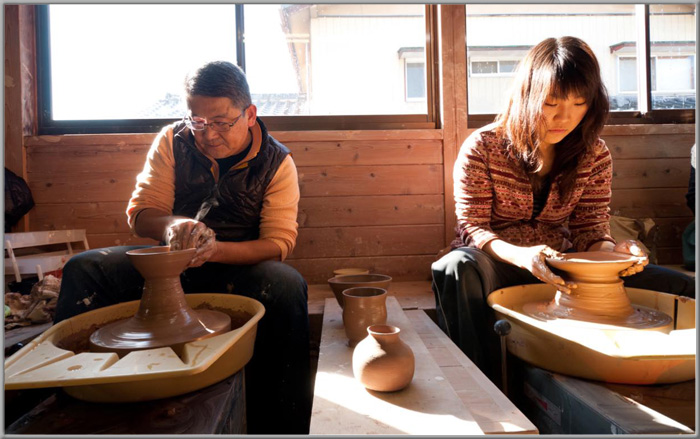
Caption: At Mashiko Ceramic Art Club, people from all walks of life gather to make pottery using the world-renowned Mashiko-yaki process.
Credit: MASATOSHI SAKAMOTO
Creative Breaks
Wherever you travel in Japan, you will find workshops where traditional crafts made using local natural resources continue to turn out beautiful, unique products for discerning customers. Quite often, visitors to these workshops are able to try their hand at the crafts themselves. We visited two such workshops, in Mashiko, Tochigi Prefecture, and in Sumida Ward, downtown Tokyo.
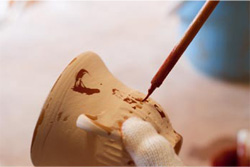
Before glazing, a potter at Mashiko Ceramic Art Club inscribes her design.
Credit: MASATOSHI SAKAMOTO
Mashiko-yaki Pottery
About two hours drive north from Tokyo lies Mashiko, a town in Tochigi Prefecture that is well known for its pottery. The town center has rows of stores selling Mashiko-yaki pottery and ceramics and was bustling with tourists visiting to shop or make pottery.
Mashiko-yaki's origins lie at the end of the Edo period (1603–1867), when everyday items such as water bottles, teapots and pots were produced there. Mashiko-yaki began to be considered as artistry when Shoji Hamada (1894–1978), a leading Japanese potter, moved to Mashiko and started making pottery there. The pottery is now well known both in Japan and overseas. The town's reputation is one of the reasons why about thirty foreign potters from places such as the United States and Australia are living and practicing in Mashiko.
"The attraction of Mashiko is that anyone is accepted. This is the free nature of the place," says Ryoichi Furuki, the owner of the Mashiko Ceramic Art Club and one of 400 potters in the town. "Many people come together here, giving rise to the various styles of Mashiko-yaki."
The process of making Mashiko-yaki takes about one month. Items are first shaped from clay using a pottery wheel. Then after drying, they are fired in a kiln and glazed using glaze made from materials such as ash, limestone and iron mixed with water. Items are completed after baking in a kiln once more.
Mashiko has many workshops in which visitors can experience this process for themselves. The Mashiko Ceramic Art Club also offers accommodation, and residents are said to include people lovingly tending to their ceramics. A half-day plan at the Club involves participants making pottery with a wheel, allowing even beginners to feel comfortable making a visit. For an additional fee, it is possible to have the item fired and sent on to you later.
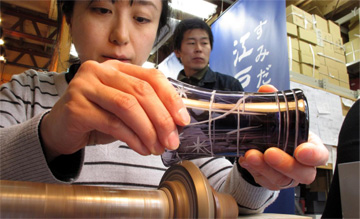
A visitor to Sumida Edo Kirikokan tries her hand at making Edo Kiriko cut glass.
Credit: TADASHI AIZAWA
Many overseas visitors have visited the Mashiko Ceramic Art Club in recent years, from countries including the United States, France and China. Last year about 1,230 people are said to have made pottery at the Club, with about 260 of them being non-Japanese.
Edo-Kiriko Cut Glass
Edo-Kiriko glassware is believed to have first been made by glass merchant Kagaya Kyubei in Edo (present day Tokyo) in the nineteenth century when Kagaya cut a pattern into glass. The basic production method involves cutting out a delicate pattern on colored glass cups or dishes using a disc-shaped blade. This method has not changed despite advances in automation and material research. The pieces are created one by one by an experienced craftsman, meaning that no two items are ever the same.
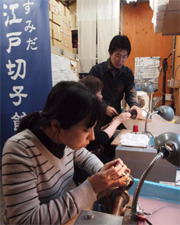
An instructor at Sumida Edo Kirikokan teaches visitors to the workshop how to cut glass.
Credit: TADASHI AIZAWA
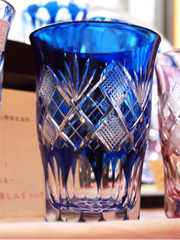
One example of some of the wide range of Edo Kiriko glassware on sale at Sumida Edo Kirikokan
Credit: TADASHI AIZAWA
"It is said to take ten years to become a fully fledged craftsman," instructor Eiichi Yoshikawa says. "I want people to have fun even if they can't do it very well and hope they gain an interest in Edo-Kiriko." The number of foreign participants has reportedly increased recently with many said to attempt daring designs.
Sumida Edo Kirikokan is located in the vicinity of the Tokyo Sky Tree and is developing and selling products such as those with a Sky Tree motif to tie-in with the tower's opening next year.
© 2009 Cabinet Office, Government of Japan






